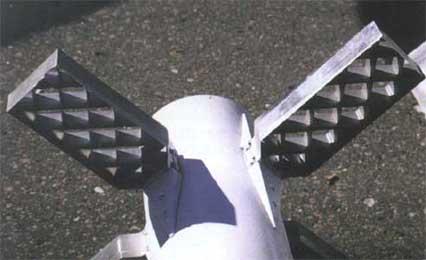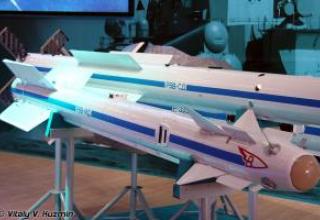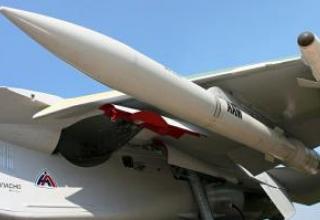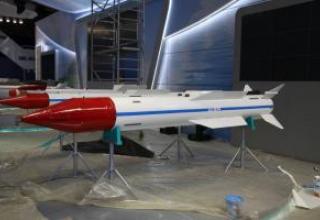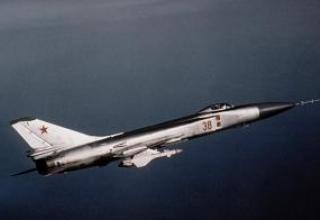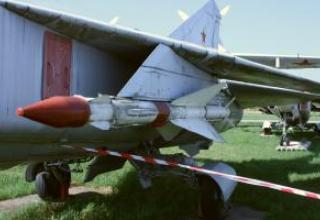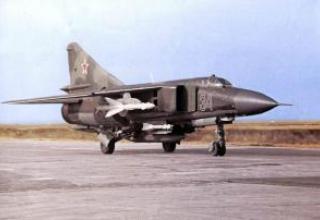Medium-range missile R-77 (RVV-AE) is designed to engage fighters, attack aircraft, bombers, aircraft and helicopters of the enemy's military transport aviation in air battles at medium ranges, day and night, in simple and difficult weather conditions, from any direction, on the background of land and sea, with active information and maneuverable counteraction of the enemy.
The rocket took place in the State Design Bureau "Vympel" creation cycle in 1982 - 1989. One of the main requirements for it was the compactness, allowing the missiles to be placed on the inner suspension of promising combat aircraft to improve aerodynamic performance and reduce visibility. It was adopted for service in February 1994. It is equipped with modifications of the 4th generation fighters - MiG-29SD (SE, SM, M), Su-35, Su-37, MiG-31M and others.
Immediately after the information about the "Product-170" (as in the project it was called RVV-AE, which later became known in NATO - "AAM-AE" (Air-to-Air Missile, Actve, Energetic), and in Russian aircraft - R-77) in 1992, Western journalists nicknamed it "Amraamski" (hinting at its similarity to the American AMRAAM - AIM-120A).
In terms of its tactical and technical characteristics, the RVV-AE is significantly superior to the domestic R-24, R-27, foreign AIM-7F Sparrow, Skyflash, and Matra super 530F missiles, and in terms of a number of characteristics - the American AMRAAM-120A.
The Vympel State Design Bureau is upgrading the R-77 missile in order to increase its efficiency, range, manufacturability and unify its application in other complexes. It is planned to equip the missile with infrared GSN with target acquisition on the flight path. The variants with the combined rocket-straight engine, allowing to increase the range, for the destruction of the DRLO aircraft at the distances up to 150 km, are developed.
On the basis of R-77 designed anti-aircraft missile, different from the prototype with an increased diameter of RDTT.
Composition:
R-77 is a medium-range guided missile with an active homing radar system. R-77 is used for the following purposes: highly maneuverable aircraft, cruise missiles, ground-to-air and air-to-air missiles, strategic bombers, helicopters, including hanging mode, etc. Provides hitting targets from any direction at all angles, day and night, in simple and difficult weather conditions, in the conditions of REP, on the background of the earth and water surface on the principle of "let-forget", including with multi-channel firing.
The RVV-AE intercepts targets flying at speeds up to 3600 km/h in the range of altitudes from 20 m to 25 km with exceeding (downgrading) the targets relative to the launch vehicle up to 10 km and does not impose restrictions on overloading the launch vehicle at the moment of launch. Launch range for high-flying targets is up to 80 km, with the capture of the target of its own GSN at a range of 20 km. Defeat of low-flying targets is possible at a range of up to 20 km, inhaling - up to 25 km. The missile is capable of engaging targets that maneuver with an overload of up to 12 units. Can attack targets at a 90° angle relative to the aircraft - the carrier.
The P-77 missile (see the scheme) is made according to the normal aerodynamic scheme, the wing is reduced to narrow plates of thin profile, and the rudders, located on the tail, can be folded and have a lattice structure, with low resistance and stable swivel moment in the entire range of speeds, heights and angles of attack in a continuous flow. Such rudders, first tested on the Tochka ballistic missile, allow for conformal and intra-football placement of the missile on an aircraft carrier and determine its high maneuverability characteristics. Each surface consists of a metal frame with a knife-shaped grating inside it. This design provides a larger control area with less weight. In addition, less powerful drives are required to operate these rudders than for classic planes. The required torque does not exceed 1.5 kGm, which allowed the use of small and lightweight electric steering gears. Rudders maintain efficiency at angles of attack up to 40 °, as a result of increased maneuverability at large angles of attack, bringing it at the P-77 to 150 ° / sec. Folding rudders allowed to make the rocket compact, "laying" it in a square with sides 300mm. The R-77 solid propellant engine allows it to reach a speed of M = 4.
R-77 has a combined guidance: inertial with radiocorrection with the transition to an active radar on the signal of an on-board computer, which determines the target acquisition distance of its own SN type 9B1348E. In case of a hijacking failure, the formation of a "mathematical model" of the target is continued with the help of the carrier aircraft, allowing a trajectory capture of the target or redirect the missile to another target. Under conditions of interference, the CNS can passively hover over their source, combined with the target, and hit the defender on its own signals. If the battle is at the shortest range, the active head is immediately activated and the guidance is provided without the use of a command-inertial phase. A modified proportional guidance method is used in all modes of application. And in the conditions of organized interference, in which the onboard radar station of the carrier can not provide the missile with information about the range and speed of approaching the target, guidance is carried out on special trajectories.
The missile is equipped with a laser fuse. Its work consists in irradiating the target and determining the moment of detonation of the combat unit (at an optimal distance from the target) by the reflected signal. The parameters of the fuse are adapted to the size of the target. A contact fuse is also provided for direct hitting or falling on the ground or water surface for self-liquidation purposes. The missile's warhead is a rod with microcumulative elements. The rods are connected to each other so that when detonated, they form a solid expanding ring that literally cuts the target. Microcumulative components of the combat unit hit high-precision targets in the missile defense mode of the aircraft carrier.
For the suspension of the missile are booster launchers-170 and catapult AKU-170, providing launch from the inner compartments of the carrier.
Characteristics:
| The length of the rocket, mm | 3600 |
| The diameter of the rocket, mm | 200 |
| Caliber, mm | 200 |
| Wingspan, mm | 454 (400) |
| Finger scale, mm | 750 (740) |
| Missile launch weight, kg | 175 |
| Weight of combat unit, kg | 22 (18) |
| Type of combat unit | microcumulative rod |
| Maximum launch range, km | 80 |
| Minimum launch range, km | 0,3 |
| Overloading of affected targets | 12 |
| Speed, number M | 4,5 |
| Probability of hitting the target | 0,7 |
Testing:
R-3C was baptized in battle in Vietnam and then in the Middle East. It proved to be a good weapon, unpretentious and reliable. However, TGSN R-3S was sensitive to weather conditions (rain and cloud cover absorbed infrared radiation), the attack was possible only from the rear hemisphere, and to evade it, the enemy used to evade the sun - a powerful natural source of heat (at night such a false target could be a "cold" moon). The launch performance was also affected by the missile's limited maneuverability when flying to the target, its inability to descend from the track at high overloads in combat and insufficiently powerful combat unit. The area of possible attacks was also reduced by the minimum allowed range (it was determined by the inability of the TGSN to track the target moving fast on azimuth and its own safety in case of a BC explosion).
For 1966. - the first year of use of R-ZS missiles in Vietnam, they were hit by 16 out of 57 American aircraft shot down by fighter aircraft. Their efficiency was 35% at 46 launches. Skills and more careful observance of tactical recommendations allowed next year to increase the effectiveness of missile attacks: in 53 battles MiG-21 shot down 50 planes. The overwhelming majority of R-3C launches were carried out from behind at short ranges (1200 - 2500m), only 5% of the attacks were carried out from distances over 2500m.
Shortcomings in training and tactics affected the use of missiles in the Middle East battles: sharp maneuvers of impulsive Arab pilots who did not comply with the prescribed modes of launch, led to unsuccessful launches and wasted missiles. Thus, in the group battle on November 3, 1968, the price of victory over two Israeli "Mirages" was 13 spent by the Egyptians R-3C. In the Indo-Pakistan conflict in December 1971, out of 10 victories won by Indian MiG-21, 8 were achieved with the use of guns and only 2 with the launch of R-3C.
Sources:
- R-77RVV-AE (AA-12 ADDER) (http://www.bharat-rakshak.com)
- Авиабаза =KRoN=
- В.Марковский, К.Перов. Развитие советских авиационных ракет класса "воздух-воздух".М-Хобби

